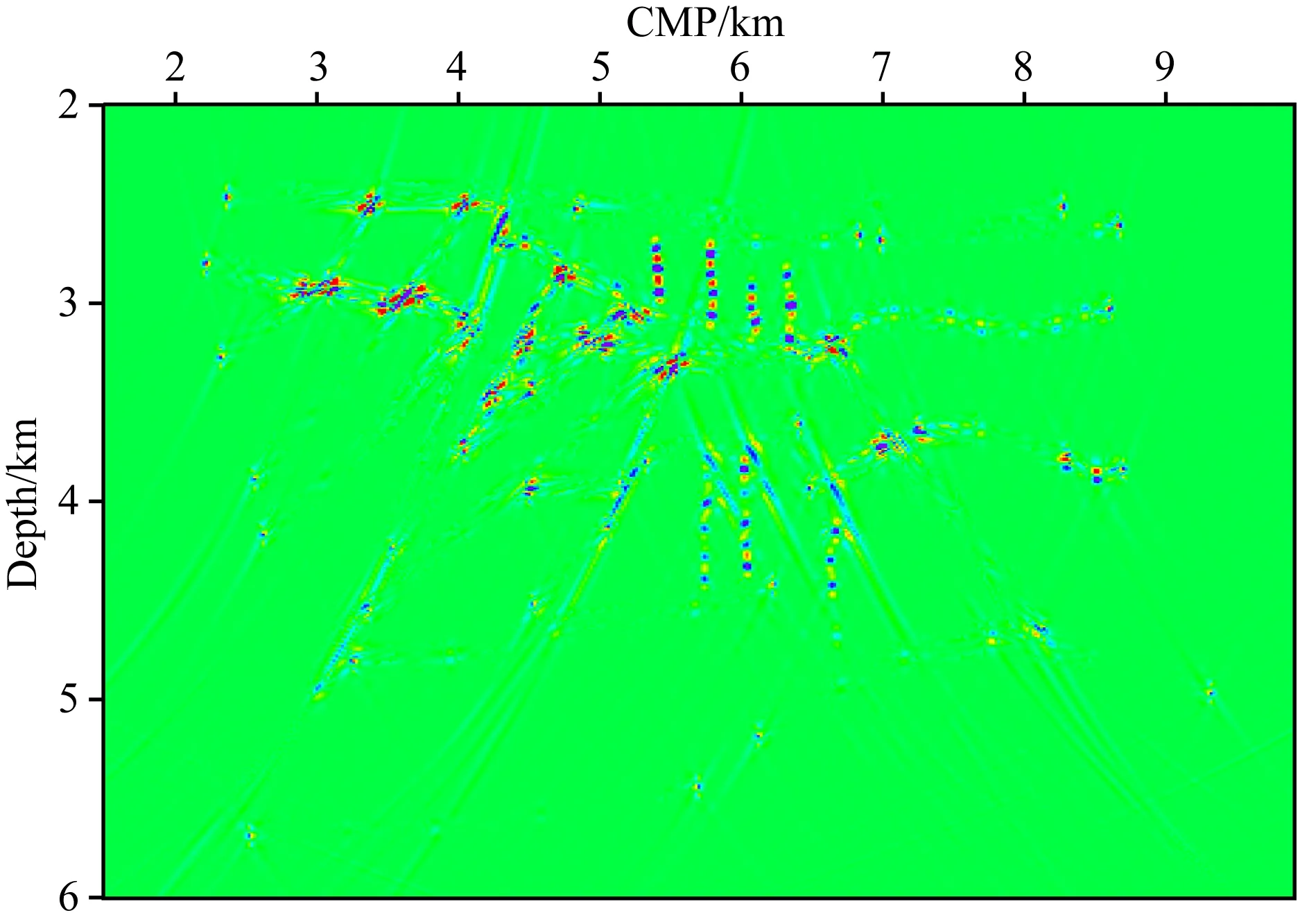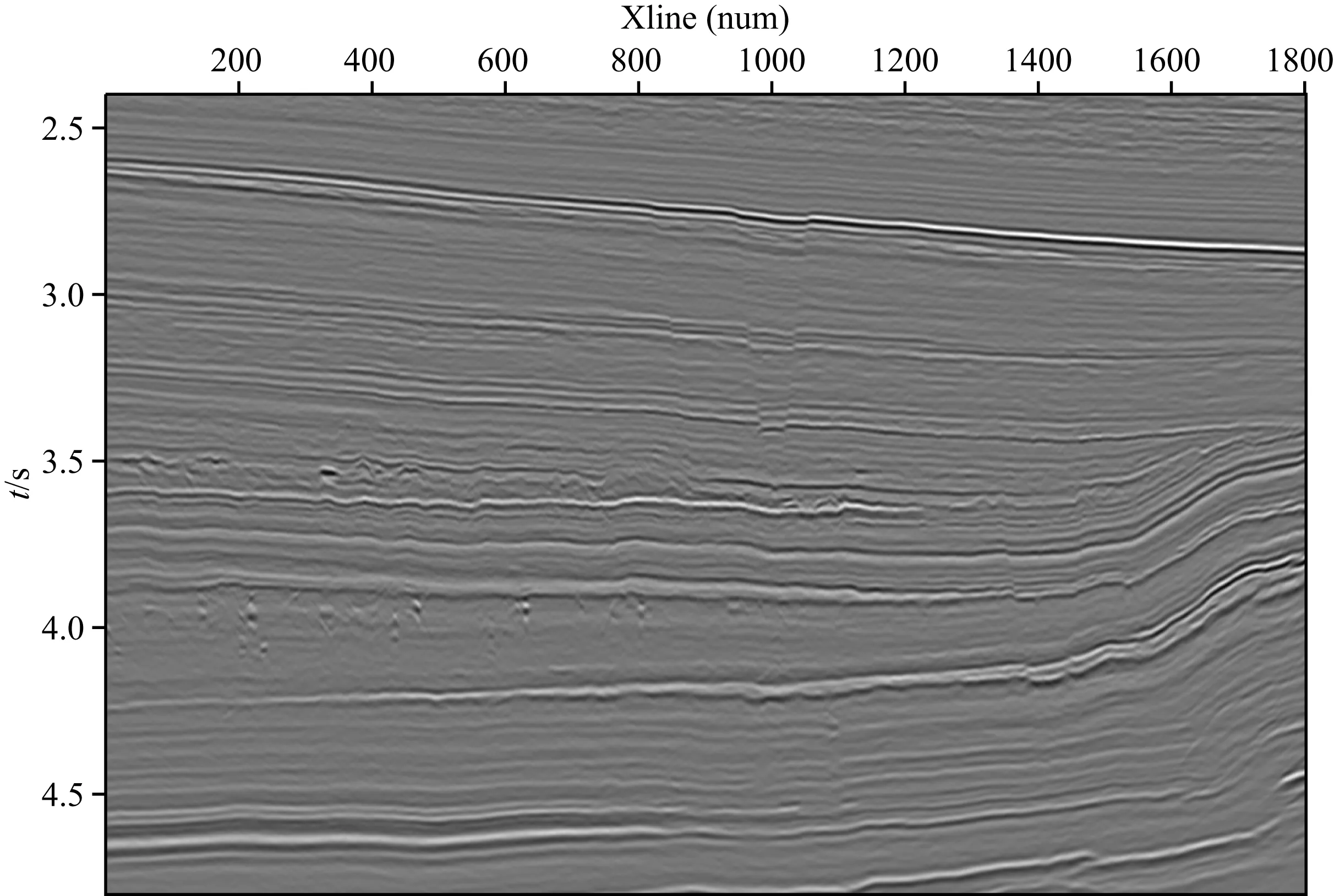基于地震成像数据稀疏反演的不连续及非均质地质体检测方法
赵惊涛, 于彩霞, 彭苏萍, 马德波, 李明, 张研
1 中国矿业大学(北京) 煤炭资源与安全开采国家重点实验室, 北京 100083 2 中国科学院地质与地球物理研究所, 中国科学院油气资源研究重点实验室, 北京 100029 3 中国石油天然气股份有限公司勘探开发研究院, 北京 100083
基于地震成像数据稀疏反演的不连续及非均质地质体检测方法
赵惊涛1, 于彩霞2, 彭苏萍1, 马德波3, 李明3, 张研3
1 中国矿业大学(北京) 煤炭资源与安全开采国家重点实验室, 北京 100083 2 中国科学院地质与地球物理研究所, 中国科学院油气资源研究重点实验室, 北京 100029 3 中国石油天然气股份有限公司勘探开发研究院, 北京 100083
本文针对油气藏储层预测中的不连续及非均质地质信息识别问题,研究基于地震成像数据的稀疏反演方法.由于该类地质体的地震响应特征为弱信号,因此利用平面波破坏滤波器由地震成像数据中去除强反射同相轴.在此基础上,对剩余的地震数据进行非线性加强滤波,并构建L1稀疏反演模型.为有效求解L1模型,采用非光滑泛函L1范数逼近和拟牛顿求解算法.该方法考虑稀疏先验信息,能够提高反演结果信噪比.缝洞模型测试验证该方法在检测断点、微断裂、散射点等小尺度地质体上的有效性,塔北缝洞型碳酸盐岩储层预测的应用效果进一步证实该方法的实用性.
平面波破坏; 非线性加强滤波; 地震稀疏反演方法; 不连续及非均质地质体
The core of extracting discontinuous and inhomogeneous information lies in removing strong reflections and noises. The plane-wave destruction method uses the local plane-wave model to represent seismic structures and thus is appropriate for estimating reflections. Through subtracting the predicted reflections from seismic image data, the residual containing discontinuous and inhomogeneous information and noises are obtained. Considering the sparsity property of these small-scale geological features, an L2-L1norm model is built using a nonlinear filter for promoting the inversion signal-to-noise ratio of discontinuous and inhomogeneous information. In order to guarantee the computation efficiency in solving this sparsity model, an L1norm approximation scheme and a quasi-Newton algorithm are introduced.
A numerical experiment is designed to demonstrate the effectiveness of the proposed method in extracting small-scale discontinuous and inhomogeneous geologies. The used cavity-fracture model is composed of fractures, faults and cavities. The obvious geological targets are four series of cavities in the shallow part and three series of cavities in the deep part. Using the proposed sparse inversion method, a profile with reflections eliminated and noises destroyed is obtained and the edges, faults, fractures and cavities are completely resolved. In field application, a carbonate reservoir analysis is performed. The three-dimensional pre-stack time migration profile can clearly display large-scale layers but exposes a failure in describing discontinuous and inhomogeneous geologic features. Although coherency techniques can reveal discontinuous information, the small-scale tiny faults, fractures and cavities are beyond its detection. The proposed method succeeds in clarifying and locating these small-scale geologies. The attribute analysis based on seismic spares inversion data also provides a reference about the planer distribution of the small-scale discontinuous and inhomogeneous geologies.
Resorting to the sparsity-constraint model, a seismic inversion method performed on image data is proposed for extracting small-scale discontinuous and inhomogeneous geologies. The method can achieve high-resolution information by removing the interference of reflections and the elimination of noises. In method application, seismic discontinuous and inhomogeneous structures are required to be completely imaged. Otherwise, a further velocity analysis is needed. As an end, we suggest future research on individually extracting discontinuity and inhomogeneity, especially for carbonate reservoirs research.
1 引言
我国西部碳酸盐岩风险勘探研究中,“串珠状”溶洞体、断裂等小尺度地质体在油藏单元的形成过程中起着重要作用.因此,研究不连续及非均质地质体检测方法在油气资源储层评价中具有重要的应用价值.在石油工业界中,目前用于断层检测的方法有多种,其中地震相干技术的出现为断层自动识别提供了坚实的基础.第一代相干体算法由 Bahorich和Farmer(1995)提出,该算法基于经典的归一化互相关理论,对地震数据的品质要求较高.为适应低信噪比数据,Marfurt等(1998)提出第二代相干体算法,通过引入协方差矩阵多道相似计算提高了抗噪声能力,但均值效应却降低了地震解释的横向分辨率.Gersztenkorn和Marfurt(1999)通过计算协方差矩阵中的特征值提出了第三代相干体算法,该算法通过子空间运算使得地震解释结果既消除了噪声又提高了横向分辨率.地震相干技术的出现同时也推动了一批不连续性属性检测技术的发展,如地震属性方法(李春峰和克里斯托弗,2005;张国栋等,2010;李建雄等,2011;方海飞等,2013;陈海清等,2014; 霍丽娜等,2014;王洪求等,2014)、谱分解方法(廖新华等,1990;魏志平,2009;朱振宇等,2009;陈波等,2010;陈红等,2011;黄捍东等,2012;于豪等,2013;蔡涵鹏等,2014;王贻朋等,2014; 张晓燕等,2014)、蚂蚁追踪法(张欣,2010;王军等,2013;霍丽娜等,2014)等.为消除断裂带上的散射和绕射影响,一些学者引用了混沌属性(王伟,2009)用于衡量振幅值的规律性和混乱性.廖新华等(1990)提出基于谱分解的断层识别方法,后来张亚中等(2006)将谱分解技术应用于碳酸盐岩储层预测中.然而就目前国内碳酸盐岩风险勘探而言,关注点除了小断层、断裂等不连续构造之外,还有岩溶溶洞等非均质体,实际上它们与储层特性更为紧密相关.本文研究一种能够同时考虑不连续体构造与非均质体的检测方法.鉴于该两类地质特征在数学上可用L1非光滑范数统一表示,因此探讨一种基于地震成像数据稀疏反演的不连续及非均质地质体检测方法.
2 方法原理
小尺度不连续及非均质地质体的地震响应为弱信号,因此只有去除强振幅反射同相轴才能有效提取隐藏的信息.平面波破坏滤波器利用局部平面波模型表征地震数据,在线性同相轴预测上具有很好的应用.本文由平面波破坏滤波器预测出振幅稳定的反射同相轴,该类数据对应地震数据中的光滑构造特征.地震成像数据减去预测出的光滑数据后,剩余的数据中包含了非线性构造特征和噪声.在此基础上,通过非线性加强算子构建L1稀疏反演模型,求解出不连续非均质信息.
2.1 地震数据光滑信息预测方法
平面波破坏方法(Fomel,2002)利用局部平面波方程描述地震数据构造特征,可用于表示光滑构造,其表达式为

(1)
其中,d表示剩余地震数据, s=[s1,s2,…,sN,]T表示地震成像数据,R(σ)为线性平面波算子,σ表示地震倾角斜率,公式可详细表示为

(2)

其中,I为单位矢量,σ为倾角斜率矢量,Pi,j(σi)表示由第i道地震数据预测第j道地震数据.
方程中,s为给定的地震成像数据,Pi,j(σi)为滤波器.在地震倾角斜率求解过程中,需要给定初始倾角斜率,然后由共轭梯度法逐步迭代实现.由于本文只考虑地震数据中的光滑信息,因此选择了低阶滤波器,公式为

(3)
其中,Zt,Zx分别为变量t,x的Z变换.
考虑到断层、裂缝、溶洞等地质异常体倾角斜率无法准确估计,因此在上述预测方法中该类信息被分离出来.经过上述平面波破坏滤波后,得出的剩余地震数据d中包含了地震数据中的不连续及非均质地震信息.2.2 基于稀疏反演的不连续及非均质地质体检测方法
由于不连续及非均质地震信息为非线性构造,因此要想从剩余地震数据d中分离出有效信息,需要利用非线性构造加强滤波方法(Liu et al.,2010; 刘洋等,2014),这里用算子D(σ)表示,它可以是高斯相似均值滤波(Liu et al.,2009)或下-上-中滤波(Hardie and Boncelet,1993),本文选用下-上-中滤波(Liu et al.,2010),公式为
(4)
其中,r*为下-上-中滤波结果,k为平滑参数,l为锐化参数,N为样点个数,s*为样点中间值.
由于不连续及非均质信息与噪声混叠在一起,因此分离出高信噪比的地质异常体信息,需要考虑反演方法.不连续及非均质信息具有稀疏性特点,采用L1范数模型进行求解,其极小化问题为
(5)
其中,m为估计模型.
引入拉格朗日算子后,该方法等价于求解如下无约束问题,公式为

(6)
其中,α为可调节的正则化参数,Ω(m)可定义(王彦飞等,2011)为
(7)

(8)

设目标函数Jα(m)的Hessian矩阵为H(m),由于地震数据规模较大,因此本文采用拟牛顿法求解.拟牛顿法只需要计算一阶偏导数, 计算简单且运算量小, 比解析求得Hessian矩阵更加高效稳定.
目标函数Jα(m)是一个非线性方程,Jα(m)的梯度函数为

(9)
对上式求导,可得Jα(m)的梯度函数为
(10)
式中K(m)定义为
(11)

(12)
记B≈H-1(m),函数Jα(m)的梯度gk为第k次迭代的梯度gk=g(mk),方向为sk=(m)k+1-(m)k,则模型参数更新为(Wangetal.,2011)
(13)
其中,矩阵Bk迭代求解公式为
(14)
参数ωk为线性试探步长,利用下述的Armijo-Goldstein准则非精确求解获得(袁亚湘和孙文瑜,1997).
综上所述,得出逼近L1范数的拟牛顿算法如下:
(1) 给定初始值m0、常数r及单位矩阵B0=I,并令k=0.
(2) 若k≠0,计算mk及Bk.
(3) 计算g(mk),若‖g(mk)‖<ξ×max{1,‖g(m0)‖},ξ<0.1,则停止迭代,否则执行步骤4.
(5)令k=k+1,更新步骤[步骤2]中的mk及Bk,并转到步骤3.
需要注意的是停机准则为反演算法一个关键问题,对于反演问题,一般算法的精度不可能超过所提供的数据误差的精度(王彦飞,2007).采用常规的梯度能量值的大小作为停机准则,可能使得迭代陷入循环,导致计算误差的累积,这里选取的停机准则是:“若‖g(mk)‖<ξ×max{1,‖g(m0)‖},则停止迭代”,其中ξ为控制参数,取值一般小于0.1.
3 缝洞模型算例测试

图1 缝洞模型深度偏移结果Fig.1 Depth migration of a fracture-cavity model

图2 反射信息平面波预测结果Fig.2 Reflection information predicted by plane-wave method

图3 基于稀疏反演提取出的不连续及非均质地质信息Fig.3 Discontinuous and inhomogeneous geological information extracted by sparsity inversion-based method
为测试基于地震成像数据稀疏反演的不连续及非均质检测方法,模型设计上包含断点、溶洞散射体、粗糙反射界面等信息.该类地质体在地震波场模拟中产生绕射波,而绕射波为不连续及非均质信息载体,经偏移后聚焦.但聚焦后的绕射信息与反射波信息在振幅和相位上均在很大差异.与反射信息相比,绕射信息很弱,因此在常规成像结果中难以突显.图1为缝洞模型的偏移结果,主要展现层位宏观信息,而小尺度溶洞和断裂信息难以体现.利用平面波预测方法可以估计出平滑、振幅稳定的反射信息,缝洞模型平面波预测结果如图2所示.由于该算法采用低阶滤波器,因此非光滑信息包含在剩余波场中.对剩余数据进行非线性稀疏反演,结果如图3所示.对比图1和图3可见,浅层4串岩溶和深层3串岩溶在图3中能够显现,并且图3中提取出断点和断裂等不连续信息.在计算过程中,正则化参数α对反演结果起着关键作用:α越大稀疏约束越强,α越小平滑特征越明显.本文给出的方法利用数学上的L1稀疏范数,因此在原理上能够更好保护不连续及非均质地质信息.与真实设计模型相比,稀疏不连续及非均质提取方法在断点、溶洞和断裂表征上具有明显优势,并且能够去除偏移噪声.虽然图3中有些地方存在残余线性同相轴影子,但这是由于该同相轴振幅存在微小变化的原因,这也反应稀疏不连续及非均质提取方法的灵敏性.去除连续地质信息后,图3展示沉积间断点、断层、溶洞、粗糙反射界面等信息.该类地质信息在油气藏储层研究中具有重要应用价值.
缝洞模型测试结果表明,基于稀疏反演的不连续及非均质地质体检测方法,能够清楚刻画与油气运移通道有关的地质构造及溶洞储层信息.
4 实际资料应用
国外碳酸盐岩油气藏普遍以相对均质的生物礁、白云岩风化壳等为有效储层,构造较为完整,较少涉及储层非均质问题.而国内碳酸盐岩油气藏,存在年代久远,极强的非均质性是多数碳酸盐岩油气藏典型特征.尤其在塔里木盆地风险勘探中,能够预测出与古风化壳有关的大型岩溶缝洞群,对寻找规模性油气藏具有重要意义.本实例研究难点为如何清楚刻画出与奥陶系有关的断裂、溶洞等不连续及非均质地质体.
三维叠前时间偏移成像结果如图4所示,图中3.5s位置为风化壳界面,4.0s为“串珠状”溶洞发育位置.虽然图4在一定程度上体现风化壳界面振幅变化情况和断面形态,同时显示出溶洞影子,但对顺层岩溶刻画程度不够.图5为线性预测结果,该图主要保留宏观光滑同相轴,无法刻画断裂、溶洞等地质单元.应用基于稀疏反演的不连续非均质检测方法,得到的剖面如图5所示.去除平滑背景后,图5中小断层表现明显,风化壳破碎描述清楚,更为重要的是能够很好显示顺层岩溶.
为进一步研究断裂、溶洞等地质单元平面展布,分析奥陶系地震属性特征.图7a为沿层相干属性,相干体技术能够将地震数据转换为相似系数,以突出断层、断裂等非相关信息.相干属性图7a清楚描述古河道形态,但难以刻画溶洞、微断层等小尺度地质体.与图7a对比,基于稀疏反演得到的均方根振幅属性图7b展现出溶洞平面分布情况并清晰刻画断裂特征.
塔北四连片地震数据分析证实,基于稀疏反演的不连续及非均质地质检测方法,能够反映小尺度断层、断裂等不连续性构造,刻画溶洞等非均质体,在碳酸盐岩油气藏研究中具有重要意义.

图4 三维叠前时间偏移剖面Fig.4 Three-dimensional pre-stack time migration profile

图5 平面波预测剖面Fig.5 Profile predicted by plane-wave method

图6 基于稀疏反演方法提取的不连续及非均质信息Fig.6 Discontinuous and inhomogeneous geological information extracted by sparsity inversion-based method

图7 奥陶系沿层地震属性(a) 相干属性; (b) 分离出的不连续非均质数据的均方根振幅属性.Fig.7 Seismic attributes along the Ordovician layer(a) Coherence attribute; (b) RMS (Root-Mean-Square) amplitude attribute of separated data containing discontinuous and inhomogeneous information.
5 结论
通过构建L1稀疏反演模型,本文给出一种不连续及非均质地质体检测方法,该方法能够分离出小断层、断裂、溶洞等小尺度构造地质单元.在方法研究与应用中,得出以下结论:
(1) 本文在线性平滑信息预测上,采用平面波破坏滤波器,其他方法如F-K滤波、中值滤波等能够达到类似技术效果;
(2) 为提高不连续及非均质地质体分离信噪比,本文构建L1稀疏模型,并采用分段函数逼近策略和拟牛顿数值方法求解,该算法适用于三维高密度地震数据处理.
(3) 方法应用要求地震数据中不连续及非均质信息成像,如果速度模型不准确,需要进一步速度分析.
(4) 如何将小尺度不连续信息与非均质信息分开,单独应用非均质特征研究“串珠状”储层,可作进一步探讨.
致谢 感谢编辑部老师的辛勤工作,感谢审稿专家百忙之中对本文的热心审阅!
Bahorich M, Farmer S. 1995. 3-D seismic discontinuity for faults and stratigraphic features: The coherence cube.TheLeadingEdge, 14(10): 1053-1058.
Cai H P, He Z H, Li Y L, et al. 2014. Instantaneous spectrum decomposition and fast interpretation of broadband seismic data.OilGeophysicalProspecting(in Chinese), 49(5): 932-939.
Chen B, Wei X D, Ren D Z, et al. 2010. Small fault identification based on spectrum decomposition technique.OilGeophysicalProspecting(in Chinese), 45(6): 890-894.
Chen H, Peng Z M, Wang J, et al. 2011. Spectral decomposition of seismic signal based on fractional Gabor transform and its application.ChineseJournalofGeophysics(in Chinese), 54(3): 867-873.
Chen H Q, Bai J, Zou W, et al. 2014. Fractured reservoir prediction in Liugouzhuang with seismic attribute approaches provided by GeoEast.OilGeophysicalProspecting(in Chinese), 49(S1): 154-159.
Fang H F, Zhou S, Wang Y L, et al. 2013. Geometric attribute improved-processing in fault interpretation.OilGeophysicalProspecting(in Chinese), 48(S1): 120-124.
Fomel S. 2002. Application of plane-wave destruction filters.Geophysics, 67(6): 1946-1960. Gersztenkorn A, Marfurt K J. 1999. Eigenstructure based coherence computations as an aid to 3-D structural and stratigraphic mapping.Geophysics, 64(5): 1468-1479. Hardie R C, Boncelet C G. 1993. LUM filters: A class of Rank-Order-Based filters for smoothing and sharpening.IEEETransactionsonSignalProcessing, 41(3): 1061-1076.Huang H D, Guo F, Wang J B, et al. 2012. High precision seismic time-frequency spectrum decomposition method and its application.OilGeophysicalProspecting(in Chinese), 47(5): 773-780. Huo L N, Zhang J J, Zheng L H, et al. 2014. Fault interpretation with multiple attributes in coalbed methane interpretation.OilGeophysicalProspecting(in Chinese), 49(S1): 221-227.
Li C F, Liner C. 2005. Singularity exponent from wavelet-based multiscale analysis: A new seismic attribute.ChineseJ.Geophys. (in Chinese), 48(4): 882-888.
Li J X, Cui Q Z, Wei X D. 2011. Application of seismic attributes in micro-fault interpretation.OilGeophysicalProspecting(in Chinese), 46(6): 925-929.
Liao X H, Yan P F, Chang T. 1990. Automatic faults recognition using spectrum decomposition.ActaGeophysicaSinica(in Chinese), 33(2): 220-226. Liu G C, Fomel S, Jin L, et al. 2009. Stacking seismic data using local correlation.Geophysics, 74(3): V43-V48.
Liu Y, Fomel S, Liu G C. 2010. Nonlinear structure-enhancing filtering using plane-wave prediction.GeophysicalProspecting, 58(3): 415-427. Liu Y, Wang D, Liu C, et al. 2014. Structure-oriented filtering and fault detection based on nonstationary similarity.ChineseJ.Geophys. (in Chinese), 57(4): 1177-1187, doi: 10.6038/cjg20140415.
Marfurt K J, Kirlin R L, Farmer S L, et al. 1998. 3-D seismic attributes using a semblance-based Coherence algorithm.Geophysics, 63(4): 1150-1165. Wang H Q, Yang W Y, Xie C H, et al. 2014. Azimuthal anisotropy analysis of different seismic attributes and fracture prediction.OilGeophysicalProspecting(in Chinese), 49(5): 925-931.
Wang J, Li Y D, Gan L D. 2013. Fracture characterization based on azimuthal anisotropy of ant-tracking attribute volumes.OilGeophysicalProspecting(in Chinese), 48(5): 763-769.
Wang W. 2009. Technology of seismic geometric attributes for fault identification and its application [Master thesis] (in Chinese). Qingdao: China University of Petroleum.
Wang Y F. 2007. Computational Methods for Inverse Problems and Their Applications (in Chinese). Beijing: Higher Education Press.
Wang Y F, Stepanova I E, Titarenko V N, et al. 2011. Inverse Problems in Geophysics and Solution Methods (in Chinese). Beijing: Higher Education Press.
Wang Y F, Yagola A G, Yang C C. 2011. Optimization and Regularization for Computational Inverse Problems and Applications. New York: Springer.Wang Y P, Xie J P, Han W G, et al. 2014. Thin bed prediction based on spectral decomposition.OilGeophysicalProspecting(in Chinese), 49(3): 561-566.
Wei Z P. 2009. Application of spectrum-decomposition tuning body technique to quantitatively predict thin reservoir.OilGeophysicalProspecting(in Chinese), 44(3): 337-340. Yu H, Li J S, Zhang Y, et al. 2013. Spectral decomposition in fault and reservoir identifications.OilGeophysicalProspecting(in Chinese), 48(6): 954-959.
Yuan Y X, Sun W Y. 1997. Optimization Theory and Method (in Chinese). Beijing: Science Press.
Zhang G D, Liu X, Tian L H, et al. 2010. Integrated application of seismic attribute and seismic inversion in reservoir characterization.OilGeophysicalProspecting(in Chinese), 45(S1): 137-144.Zhang X. 2010. Application of ant tracing algorithm in fault automatic interpretation: a case study on Fangheting structure in Pinghu Oilfield.OilGeophysicalProspecting(in Chinese), 45(2): 278-281.
Zhang X Y, Peng Z M, Zhang P, et al. 2014. Spectral decomposition of seismic signal based on fractional Wigner Ville distribution.OilGeophysicalProspecting(in Chinese), 49(5): 839-845.
Zhang Y Z, Zhao Y H, Lu X B, et al. 2006. Application of spectral factorization technique to predict carbonate fracture-vuggy reservoir in TH area of northern Tarim basin.OilGeophysicalProspecting(in Chinese), 41(S1): 16-20, 24.
Zhu Z Y, Lü D Y, Sang S Y, et al. 2009. Research of spectrum decomposition method based on physical wavelet transform and its application.ChineseJ.Geophys. (in Chinese), 52(8): 2152-2157, doi: 10.3969/j.issn.0001-5733.2009.08.025.
附中文参考文献
蔡涵鹏, 贺振华, 李亚林等. 2014. 宽频带地震数据瞬时谱分解及快捷解释方法. 石油地球物理勘探, 49(5): 932-939.
陈波, 魏小东, 任敦占等. 2010. 基于谱分解技术的小断层识别. 石油地球物理勘探, 45(6): 890-894.
陈红, 彭真明, 王峻等. 2011. 地震信号分数阶Gabor变换谱分解方法及应用. 地球物理学报, 54(3): 867-873.
陈海清, 白军, 邹雯等. 2014. GeoEast属性分析技术在柳沟庄裂缝储层预测中的应用. 石油地球物理勘探, 49(S1): 154-159.
方海飞, 周赏, 王永莉等. 2013. 几何类属性深度处理技术在断层解释中的应用. 石油地球物理勘探, 48(S1): 120-124.
黄捍东, 郭飞, 汪佳蓓等. 2012. 高精度地震时频谱分解方法及应用. 石油地球物理勘探, 47(5): 773-780.
霍丽娜, 张建军, 郑良合等. 2014. 多属性断层解释技术在煤层气储层解释中的应用. 石油地球物理勘探, 49(S1): 221-227.
李春峰, 克里斯托弗. 2005. 基于小波多尺度分析的奇性指数: 一种新地震属性. 地球物理学报, 48(4): 882-888.
李建雄, 崔全章, 魏小东. 2011. 地震属性在微断层解释中的应用. 石油地球物理勘探, 46(6): 925-929.
廖新华, 阎平凡, 常迵. 1990. 基于谱分解的断层自动识别. 地球物理学报, 33(2): 220-226.
刘洋, 王典, 刘财等. 2014. 基于非平稳相似性系数的构造导向滤波及断层检测方法. 地球物理学报, 57(4): 1177-1187, doi: 10.6038/cjg20140415.
王洪求, 杨午阳, 谢春辉等. 2014. 不同地震属性的方位各向异性分析及裂缝预测. 石油地球物理勘探, 49(5): 925-931.
王军, 李艳东, 甘利灯. 2013. 基于蚂蚁体各向异性的裂缝表征方法. 石油地球物理勘探, 48(5): 763-769.
王伟. 2009. 地震几何属性识别断层技术研究及应用[硕士论文]. 青岛. 中国石油大学(华东).
王彦飞. 2007. 反演问题的计算方法及其应用. 北京: 高等教育出版社.
王彦飞, 斯捷潘诺娃, 提塔连科等. 2011. 地球物理数值反演问题. 北京: 高等教育出版社.
王贻朋, 谢金平, 韩文功等. 2014. 基于谱分解的薄层预测方法. 石油地球物理勘探, 49(3): 561-566.
魏志平. 2009. 谱分解调谐体技术在薄储层定量预测中的应用. 石油地球物理勘探, 44(3): 337-340.
于豪, 李劲松, 张研等. 2013. 频谱分解技术在断层与储层识别中的应用. 石油地球物理勘探, 48(6): 954-959.
袁亚湘, 孙文瑜. 1997. 最优化理论与方法. 北京: 科学出版社.
张国栋, 刘萱, 田丽花等. 2010. 综合应用地震属性与地震反演进行储层描述. 石油地球物理勘探, 45(S1): 137-144.
张欣. 2010. 蚂蚁追踪在断层自动解释中的应用—以平湖油田放鹤亭构造为例. 石油地球物理勘探, 45(2): 278-281.
张晓燕, 彭真明, 张萍等. 2014. 基于分数阶Wigner-Ville分布的地震信号谱分解. 石油地球物理勘探, 49(5): 839-845.
张亚中, 赵裕辉, 鲁新便等. 2006. 频谱分解技术在塔里木盆地北部TH地区碳酸盐岩缝洞型储层预测中的应用. 石油地球物理勘探, 41(S1): 16-20, 24.
朱振宇, 吕丁友, 桑淑云等. 2009. 基于物理小波的频谱分解方法及应用研究. 地球物理学报, 52(8): 2152-2157, doi: 10.3969/j.issn.0001-5733.2009.08.025.
(本文编辑 张正峰)
Seismic sparse inversion method implemented on image data for detecting discontinuous and inhomogeneous geological features
ZHAO Jing-Tao1, YU Cai-Xia2, PENG Su-Ping1, MA De-Bo3, LI Ming3, ZHANG Yan3
1StateKeyLaboratoryofCoalResourcesandSafeMining,ChinaUniversityofMiningandTechnology(Beijing),Beijing100083,China2InstituteofGeologyandGeophysics,ChineseAcademyofSciences,KeyLaboratoryofPetroleumResourcesResearch,ChineseAcademyofSciences,Beijing100029,China3ResearchInstituteofPetroleumExploration&Development,PetroChina,Beijing100083,China
The small-scale discontinuous and inhomogeneous geological features, such as tiny faults, cavities and fractures, play an important role in reservoir analysis. However, to effectively identify them from seismic data is a challenging problem because of their weaker energy than reflections. On the other hand, the seismic responses of these small-scale bodies are generally contaminated with noises, which can make their analysis difficult to perform if there is no proper strategy adopted for removing noises. By combining a non-linear filter and sparsity-constraint model, a seismic extraction method implemented on seismic image data is developed for inverting these discontinuous and inhomogeneous geological bodies.
Plane-wave destruction; Nonlinear enhancing filter; Seismic sparse inversion method; Discontinuity and inhomogeneity
10.6038/cjg20160923.Zhao J T, Yu C X, Peng S P, et al. 2016. Seismic sparse inversion method implemented on image data for detecting discontinuous and inhomogeneous geological features.ChineseJ.Geophys. (in Chinese),59(9):3408-3416,doi:10.6038/cjg20160923.
国家重点研发计划课题(2016YFC0501102)、国家科技重大专项课题(2016ZX05066-001)、国家自然基金煤炭联合项目(U1261203)和山西自然基金项目(2013012001)联合资助.
赵惊涛,男,1982年生,2007年毕业于中国地质大学(北京),2013年获中国科学院地质与地球物理研究所博士学位,主要从事复杂构造地震波成像方法研究.E-mail:diffzjt@163.com
10.6038/cjg20160923
P631
2014-11-16,2015-09-21收修定稿
赵惊涛, 于彩霞, 彭苏萍等. 2016. 基于地震成像数据稀疏反演的不连续及非均质地质体检测方法.地球物理学报,59(9):3408-3416,
——有效的抗弓形虫药物靶标

